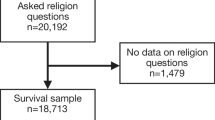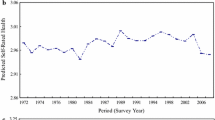Abstract
The use of longitudinal designs in the field of religion and health makes it important to understand how attrition bias may affect findings in this area. This study examines attrition in a 4-wave, 8-year study of older adults. Attrition resulted in a sample biased toward more educated and more religiously involved individuals. Conditional linear growth curve models found that trajectories of change for some variables differed among attrition categories. Ineligibles had worsening depression, declining control, and declining attendance. Mortality was associated with worsening religious coping styles. Refusers experienced worsening depression. Nevertheless, there was no evidence of bias in the key religion and health results.
Similar content being viewed by others
References
Chatfield, M. D., Brayne, C. E., & Matthews, F. E. (2005). A systematic literature review of attrition between waves in longitudinal studies in the elderly shows a consistent pattern of dropout between differing studies. Journal of Clinical Epidemiology, 58, 13–19.
Ellison, C. G. (1995). Race, religious involvement and depressive symptomatology in a southeastern U.S. community. Social Science and Medicine, 40, 1561–1572.
Erikson, E. H. (1968). Identity, youth, and crisis. New York: W. W. Norton.
Feng, D., Silverstein, M., Giarrusso, R., McArdle, J. J., & Bengtson, V. L. (2006). Attrition of older adults in longitudinal surveys: Detection and correction of sample selection bias using multigenerational data. Journals of Gerontology Series B: Psychological Sciences and Social Sciences, 61B, S323–S328.
George, L. K., Ellison, C. G., & Larson, D. B. (2002). Explaining the relationships between religious involvement and health. Psychological Inquiry, 13, 190–200.
Graham, J., Olchowski, A., & Gilreath, T. (2007). How many imputations are really needed? Some practical clarifications of multiple imputation theory. Prevention Science, 8, 206–213.
Hackney, C. H., & Sanders, G. S. (2003). Religiosity and mental health: A meta-analysis of recent studies. Journal for the Scientific Study of Religion, 42, 43–55.
Hayward, R. D., & Krause, N. (2013a). Patterns of change in prayer activity, expectancies, and contents during older adulthood. Journal for the Scientific Study of Religion, 52, 17–34.
Hayward, R. D., & Krause, N. (2013b). Trajectories of disability in older adulthood and social support from a religious congregation: A growth curve analysis. Journal of Behavioral Medicine, 36, 354–360.
Hayward, R. D., Owen, A. D., Koenig, H. G., Steffens, D. C., & Payne, M. E. (2012). Religion and the presence and severity of depression in older adults. American Journal of Geriatric Psychiatry, 20, 188–192.
Horton, N. J., & Lipsitz, S. R. (2001). Multiple imputation in practice. The American Statistician, 55, 244–254.
Hummer, R. A., Ellison, C. G., Rogers, R. G., Moulton, B. E., & Romero, R. R. (2004). Religious involvement and adult mortality in the United States: Review and perspective. Southern Medical Journal, 97, 1223–1230.
Idler, E. L., & Benyamini, Y. (1997). Self-rated health and mortality: A review of twenty-seven community studies. Journal of Health and Social Behavior, 38, 21–37.
Idler, E. L., & Kasl, S. V. (1992). Religion, disability, depression, and the timing of death. American Journal of Sociology, 97, 1052–1079.
Idler, E. L., Musick, M. A., Ellison, C. G., George, L. K., Krause, N., Ory, M. G., et al. (2003). Measuring multiple dimensions of religion and spirituality for health research: Conceptual background and findings from the 1998 General Social Survey. Research on Aging, 25, 327–365.
Koenig, H. G., King, D. E., & Carson, V. B. (2012). Handbook of religion and health (2nd ed.). New York: Oxford University Press.
Krause, N. (2002a). A comprehensive strategy for developing closed-ended survey items for use in studies of older adults. The Journals of Gerontology Series B: Psychological Sciences and Social Sciences, 57, S263–S274.
Krause, N. (2002b). Exploring race differences in a comprehensive battery of church-based social support measures. Review of Religious Research, 44, 126–149.
Krause, N. (2006). Religion and health in late life. In J. E. Birren & K. W. Schaie (Eds.), Handbook of the psychology of aging (6th ed., pp. 499–518). New York: Elsevier Academic Press.
Krause, N. (2008). Aging in the church: How social relationships affect health. West Conshohocken, PA: Templeton Foundation Press.
Krause, N., & Ellison, C. G. (2009). The doubting process: A longitudinal study of the precipitants and consequences of religious doubt in older adults. Journal for the Scientific Study of Religion, 48, 293–312.
Lachman, M. E., Neupert, S. D., & Agrigoroaei, S. (2011). The relevance of control beliefs for health and aging. In K. Warner Schaie & S. L. Willis (Eds.), Handbook of the psychology of aging (7th ed., pp. 175–190). San Diego, CA: Academic Press.
McCullough, M. E., & Willoughby, B. L. B. (2009). Religion, self-regulation, and self-control: Associations, explanations, and implications. Psychological Bulletin, 135, 69–93.
Mehta, P. D., & West, S. G. (2000). Putting the individual back into individual growth curves. Psychological Methods, 5, 23–43.
Mihelic, A. H., & Crimmins, E. M. (1997). Loss to follow-up in a sample of Americans 70 years of age and older: The LSOA 1984–1990. The Journals of Gerontology Series B: Psychological Sciences and Social Sciences, 52B, S37–S48.
Norris, F. H. (1987). Effects of attrition on relationships between variables in surveys of older adults. Journal of Gerontology, 42, 597–605.
Pargament, K. I., Koenig, H. G., & Perez, L. M. (2000). The many methods of religious coping: Development and initial validation of the RCOPE. Journal of Clinical Psychology, 56, 519–543.
Powell, L. H., Shahabi, L., & Thoresen, C. E. (2003). Religion and spirituality: Linkages to physical health. American Psychologist, 58, 36–52.
Radloff, L. S. (1977). The CES-D scale. Applied Psychological Measurement, 1, 385–401.
Rotter, J. B. (1966). Generalized expectancies for internal versus external control of reinforcement. Psychological Monographs: General and Applied, 80, 1–28.
Schmidt, C. O., Raspe, H., Pfingsten, M., Hasenbring, M., Basler, H. D., Eich, W., et al. (2011). Does attrition bias longitudinal population-based studies on back pain? European Journal of Pain, 15, 84–91.
Sloan, R. P., & Bagiella, E. (2002). Claims about religious involvement and health outcomes. Annals of Behavioral Medicine, 24, 14.
Strawbridge, W. J., Shema, S. J., Cohen, R. D., & Kaplan, G. A. (2001). Religious attendance increases survival by improving and maintaining good health behaviors, mental health, and social relationships. Annals of Behavioral Medicine, 23, 68.
Thygesen, L. C., Johansen, C., Keiding, N., Giovannucci, E., & Grønbæk, M. (2008). Effects of sample attrition in a longitudinal study of the association between alcohol intake and all-cause mortality. Addiction, 103, 1149–1159.
Tornstam, L. (1997). Gerotranscendence: The contemplative dimension of aging. Journal of Aging Studies, 11, 143–154.
West, B. T., Welch, K. B., & Galecki, A. T. (2007). Linear mixed models: A practical guide using statistical software. Boca Raton, FL: Chapman & Hall/CRC.
Author information
Authors and Affiliations
Corresponding author
Rights and permissions
About this article
Cite this article
Hayward, R.D., Krause, N. Forms of Attrition in a Longitudinal Study of Religion and Health in Older Adults and Implications for Sample Bias. J Relig Health 55, 50–66 (2016). https://doi.org/10.1007/s10943-014-9949-5
Published:
Issue Date:
DOI: https://doi.org/10.1007/s10943-014-9949-5




